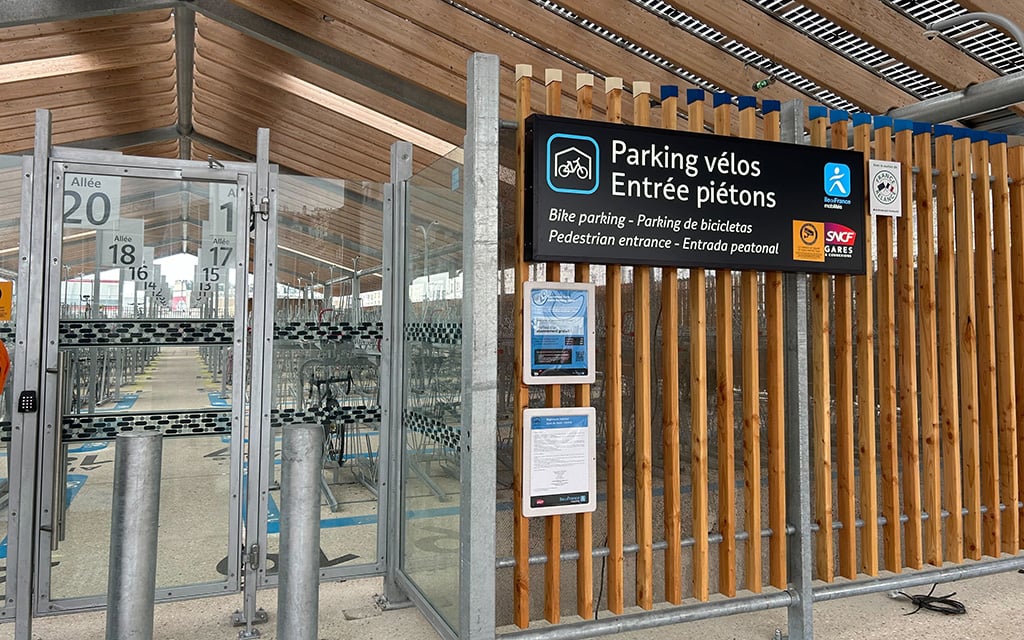A newly painted logo showcases the Paris Olympics on a bike lane near the Stade de France in Paris. The logo is one of the improvement projects the City of Paris carried out to beautify the streets near Olympic venues. (Photo by Zach Bradshaw/Special for Cronkite News)

From left, Jonathan Sorel, Christophe Najdovski, Princy Borgne, Amadea Kostrzewa, Patricia Pelloux and François Wouts give a presentation about bike infrastructure at the Paris Media Centre in Paris. (Photo by Zach Bradshaw/Special for Cronkite News)

The new bike parking facility recently constructed at the Gare du Nord train station in Paris provides additional assistance to transportation in the city. The facility can hold over 1,200 bikes. (Photo by Zach Bradshaw/Special for Cronkite News)
PARIS – The City of Light has become a “gold medal” example of modern bicycle infrastructure, making transportation during the Summer Olympics more accessible than ever.
Improvements to existing infrastructure has allowed the French capital city to also be widely known as the capital city of biking.
“It’s pretty great,” said Hannah Warmerdam, a Paris-based bike tour guide who works at Holland Bikes Tours & Rentals in Paris. “I mean, the biking infrastructure in France restarted in Paris.”
Since 2010, the city has devoted over 400 million euros, about $434.8 million, to retrofitting roads, developing parking solutions and strengthening the bicycle infrastructure. Many projects were carried out in preparation for the Olympics.
“The challenge was to ensure that this cycle network was built for the Olympic Games,” said François Wouts, director of the city’s Roads and Transport Department. “Therefore, an ambition linked to reaching each of the competition sites, but also to be able to serve the whole.”
As Los Angeles prepares to host the Olympics in 2028, Paris city officials say L.A. should make strides toward better bicycle infrastructure.
“I think that in Los Angeles there must be roads sized very largely and on which we could certainly take a little space of the volumes to the automobile and reallocate it to soft travel like the bicycle, like what we finally did in Paris,” said Christophe Najdovski, the Deputy Mayor of Paris in charge of greening public spaces, green spaces and biodiversity.
In 2015, the city announced its “Le Plan vélo de Paris,” which translates to “Paris Bicycle Plan,” a citywide goal to make transportation by bicycle easier. Over $150 million was dedicated to increasing bicycle infrastructure.
The plan’s budget was laid out:
– 70 million euros for the development of cycle paths
– 40 million euros for the integration of bicycles in the redevelopment of major roads, squares and urban projects
– 30 million euros to finance the program to generalize 30 km/h zones and make these zones two-way cycle lanes
– 6 million euros for bicycle parking
– More than 10 million euros for assistance with the purchase of bicycles, to which are added contributions from the Participatory Budget.
By 2021, Paris had more than 1,000 kilometers, about 600 miles, of cycle paths within city limits.
The plan was a success, so much so that in 2021, the city announced a second phase of the same plan, this time with an ambitious proposal: to make Paris a 100% cycle-friendly city. With it, the city would devote 250 million more euros to bike infrastructure.
The second phase is set to run until 2026, at which point the city hopes to “enable cyclists to travel on all the streets of the capital so that cycling is possible from end to end,” according to the city plan’s website.
The plans have been a major success, Najdovski said. The city has been counting bicyclists on popular routes to get a rough idea how many people are using the new cycle routes.
“We have today, for example, on the Boulevard de Sébastopol, regularly we have a counter and we regularly have figures of more than 20,000 cyclists per day on the cycle path,” Najdovski said. “Not to mention those who ride next to the path.”
In fact, “bike counters recorded an increase in the use of cycle paths of 47% on average between 2019 and 2020 and 22% between 2020 and 2021,” according to the plan’s 1st phase website.
Cycling has become increasingly popular in the large metropolitan city because it is not only more efficient than other forms of transportation, but it is more reliable.

A slide from a presentation about bike infrastructure shows how much biking improvement has helped transportation in the city. (Photo by Zach Bradshaw/Special to Cronkite News)
The advent of the Olympics caused Paris to close many metro routes and bus routes. Because of that, biking and walking were set to become the two primary modes of transportation, city officials said.
“The goal is for people to take up cycling,” said Amadea Kostrzewa, Paris 2024 Climate and Environmental Engagement Manager. “You could replace your trips by using a bike and I’m sure that everyone taking up cycling never stops, and it becomes your favorite means of transportation.”
On a recent media bike tour, officials guided journalists around the city on bikes to display some of the major improvements done to the roadways, sidewalks and stadiums.
One such project was adding a brand new bike parking facility at the Gare du Nord train station in the 10th arrondissement. The City of Paris recently constructed a fenced-off, covered bike parking facility complete with nearly 1,200 bike spots.
The City painted the Paris 2024 logo onto bike lanes near Olympic venues to help guide tourists and locals while decorating the grounds. The City also painted a large portion of the bike lanes bright green to help separate bike lanes and the sidewalk.
“You have to take the place to give it to another way of transportation. So we took the place from the cars and we gave it to the bikes,” said Leo Maljevac, a Paris resident and project manager at the Road and Mobility Department for the City of Paris. “You can just look at Paris and see our bike infrastructures really quickly.”
Maljevac said it would be incredibly difficult for a city like Paris to host the Olympics without having made upgrades to transportation options.
That’s why the City of Los Angeles, similar to Paris, has laid out plans for street improvements to accommodate more cyclists during the 2028 Summer Games.
In the LA 2028 Olympic Legacy Street Improvements Plan, the city scored upgrading bike lanes as one of the highest priorities to “prioritize mobility.”
Bike infrastructure in Paris is crucial as the Games progress, Warmerdam said. She said biking should also be at the forefront of concerns for Los Angeles, considering how effective biking has been in Paris.
“It’s the easiest way to get around Paris right now,” Warmerdam said. “And many metro lines and metro stations are also closed due to the Olympics again. So the bike is really the best way to get around Paris at the moment, and even if there are no Olympics, the bike is still the best way to get around.”
Warmerdam has yet to visit Los Angeles, but has been to New York City. She said public transportation was more difficult for her considering most American cities are “car-focused.”
“All cities should look at Paris,” she said. “Los Angeles and all cities should take example of Paris.”
Warmerdam, like many, however, are concerned with the size of Los Angeles.
The City of Paris is roughly 41 square miles in size. Los Angeles is 469 square miles.
An obvious roadblock Los Angeles officials have run into is that there will be significant distance between some Olympics venues, unlike the layout of venues in Paris is much more condensed.
“Los Angeles is massive, Paris is not that big,” Warmerdam said, echoing many sentiments already expressed in regards to the Los Angeles Olympics upgrades. “So it’s easier to make infrastructure in smaller cities.”
The City of Phoenix has dealt with similar transportation infrastructure problems to Los Angeles, largely because it is nearly 520 square miles. On such a spread-out city, it can be difficult to build reliable and financially possible transportation options, let alone efficient options.
In 2020, however, Phoenix developed a transportation vision with its Active Transportation Program to that would ensure the City “is designing enjoyable and connected active transportation infrastructure,” according to the plan’s website.
Still, many residents and critics agree Phoenix needs better transportation. A recent Yahoo! Finance article wrote: “The public transportation network in Phoenix faces criticism for its unreliability and lack of communication during service disruptions… These issues have contributed to a loss of faith in the Metro Bus and Train services.”
Warmerdam, Maljevac and Najdovski all agreed that American cities needed better transportation infrastructure. They agreed that Paris is the kind of progressive city that could be a model.
“It’s an ambition to ensure that the Olympic Games of Los Angeles of 2028 are also cycling games, and in which the infrastructures will also be accessible by bikes,” Najdovski said. “I think that there is the possibility in all the big megacities to be able to share the public space and redefine to make a new design of the public space.”

